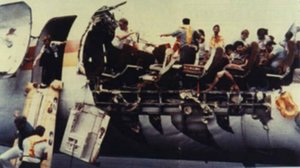Aloha Flight 243
|
|
Aloha Airlines Flight 243 was a scheduled Boeing 737-200 flight between Hilo and Honolulu in Hawaii. On April 28, 1988, the aircraft suffered extensive damage after an explosive decompression inflight, but was able to land safely at Kahului Airport on Maui. One crew member was sucked out of the airplane and another 65 passengers and crew were injured.
| Contents |
Details
On April 28, 1988, the flight (registration number N73711) took off from Hilo International Airport at 13:25 HST bound for Honolulu. There were 89 passengers and five crew members on board. No unusual occurrences were reported during the takeoff and climb.
At approximately 13:48, as the aircraft reached its normal flight altitude of 24,000 feet (7300 m) about 23 nautical miles (43 km) south-southeast of Kahului, a small section on the left side of the roof spontaneously ruptured. The resulting explosive decompression tore off a very large section of the roof, consisting of the entire top half of the aircraft skin extending from just behind the cockpit to the fore-wing area.
First Officer Madeline "Mimi" Tompkins' head was jerked back during the explosion, and she saw cabin insulation flying around the cockpit. Captain Robert Schornsteimer looked back and saw blue sky where the first class cabin's roof had been. Tompkins immediately contacted Kahului Airport on Maui declaring an emergency.
At the time of the decompression, the chief flight attendant, Clarabelle "C.B." Lansing, was standing at seat row 5 collecting drink cups from passengers. The loss of cabin pressure ejected Lansing from the plane. (It has been speculated that her body temporarily blocked a small hull rupture, causing a fluid hammer within the cabin atmosphere that greatly exacerbated the damage to the roof.) Her body was never recovered.
Flight attendant Michelle Honda, who was standing near rows 15 and 16, was thrown violently to the floor during the decompression. Despite her injuries, she was able to crawl up and down the aisle assisting and calming the terrified passengers. Flight attendant Jane Santo-Tomita, who was at the front of the plane, was seriously injured by flying debris, and was thrown to the floor. Passengers held on to her during the descent into Maui.
Despite the aircraft suffering severe structural deformation, the crew was able to perform an emergency landing on Kahului Airport's runway 2 at 13:58. In all, sixty-five people were reported injured, eight seriously. The aircraft was a total write-off.
Aftermath
After the accident, a full-scale investigation was launched by the NTSB. It concluded that the accident was caused by metal fatigue and stress fractures exacerbated by crevice corrosion [1] (http://www.corrosion-doctors.org/Aircraft/Aloha.htm). The age of the aircraft became a key issue (the aircraft was 19 years old at the time of the accident and had sustained a remarkable number of takeoff-landing cycles). Consequently, all major United States air carriers decided to retire their oldest aircraft to prevent a recurrence. Also, aircraft now receive additional maintenance checks as they age.
Dramatizations and memorials
The made for TV movie Miracle Landing is based on this incident.
In 1996, the Lansing Memorial Garden was inaugurated at Honolulu International Airport's Interisland Terminal near the gates used by Aloha Airlines.
See Also
- Honolulu International Airport
- Aloha Airlines
- List of accidents and incidents on commercial airliners
- Flight attendant
External links
- Excerpts from the NTSB Accident Report on Aloha Airlines Flt. 243 (http://www.disastercity.com/flt243)
- IMDB page for Miracle Landing (http://imdb.com/title/tt0100154/)
- Review of Miracle Landing (http://www.airodyssey.net/articles/movie-ml.html)

